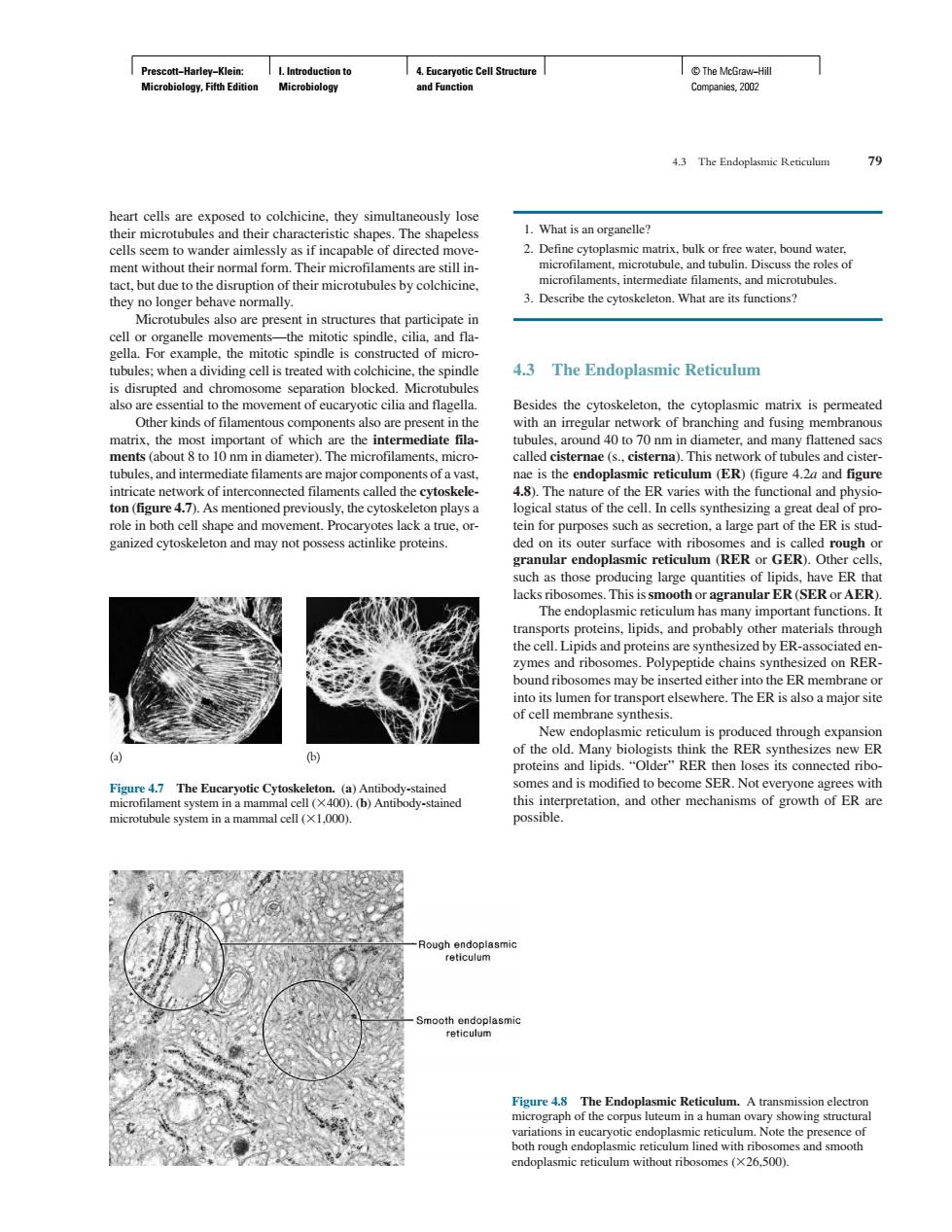正在加载图片...

er What is an organelle? ormally cyto tures that partici -the mitotic spindle,cilia,and 4.3 The Endoplasmic Reticulum ubules and intermediate filaments are maior com nents of a vast role in both cell shape and movement.Pro es lack a true or tein for purposes such as se retion.a large part of the ER is stud- ganized cytoskeleton and may not possess actinlike proteins ng large quantities of lipid have er tha This teins,lipids,and probably other materials through thesized on RER proteins nd lipids.RER then loses its conected rib 4.7 The En and smooth Prescott−Harley−Klein: Microbiology, Fifth Edition I. Introduction to Microbiology 4. Eucaryotic Cell Structure and Function © The McGraw−Hill Companies, 2002 1. What is an organelle? 2. Define cytoplasmic matrix, bulk or free water, bound water, microfilament, microtubule, and tubulin. Discuss the roles of microfilaments, intermediate filaments, and microtubules. 3. Describe the cytoskeleton. What are its functions? 4.3 The Endoplasmic Reticulum Besides the cytoskeleton, the cytoplasmic matrix is permeated with an irregular network of branching and fusing membranous tubules, around 40 to 70 nm in diameter, and many flattened sacs called cisternae (s., cisterna). This network of tubules and cisternae is the endoplasmic reticulum (ER) (figure 4.2a and figure 4.8). The nature of the ER varies with the functional and physiological status of the cell. In cells synthesizing a great deal of protein for purposes such as secretion, a large part of the ER is studded on its outer surface with ribosomes and is called rough or granular endoplasmic reticulum (RER or GER). Other cells, such as those producing large quantities of lipids, have ER that lacks ribosomes. This is smooth or agranular ER (SER or AER). The endoplasmic reticulum has many important functions. It transports proteins, lipids, and probably other materials through the cell. Lipids and proteins are synthesized by ER-associated enzymes and ribosomes. Polypeptide chains synthesized on RERbound ribosomes may be inserted either into the ER membrane or into its lumen for transport elsewhere. The ER is also a major site of cell membrane synthesis. New endoplasmic reticulum is produced through expansion of the old. Many biologists think the RER synthesizes new ER proteins and lipids. “Older” RER then loses its connected ribosomes and is modified to become SER. Not everyone agrees with this interpretation, and other mechanisms of growth of ER are possible. 4.3 The Endoplasmic Reticulum 79 Figure 4.7 The Eucaryotic Cytoskeleton. (a) Antibody-stained microfilament system in a mammal cell (400). (b) Antibody-stained microtubule system in a mammal cell (1,000). (a) (b) Figure 4.8 The Endoplasmic Reticulum. A transmission electron micrograph of the corpus luteum in a human ovary showing structural variations in eucaryotic endoplasmic reticulum. Note the presence of both rough endoplasmic reticulum lined with ribosomes and smooth endoplasmic reticulum without ribosomes (26,500). heart cells are exposed to colchicine, they simultaneously lose their microtubules and their characteristic shapes. The shapeless cells seem to wander aimlessly as if incapable of directed movement without their normal form. Their microfilaments are still intact, but due to the disruption of their microtubules by colchicine, they no longer behave normally. Microtubules also are present in structures that participate in cell or organelle movements—the mitotic spindle, cilia, and flagella. For example, the mitotic spindle is constructed of microtubules; when a dividing cell is treated with colchicine, the spindle is disrupted and chromosome separation blocked. Microtubules also are essential to the movement of eucaryotic cilia and flagella. Other kinds of filamentous components also are present in the matrix, the most important of which are the intermediate filaments (about 8 to 10 nm in diameter). The microfilaments, microtubules, and intermediate filaments are major components of a vast, intricate network of interconnected filaments called the cytoskeleton (figure 4.7). As mentioned previously, the cytoskeleton plays a role in both cell shape and movement. Procaryotes lack a true, organized cytoskeleton and may not possess actinlike proteins